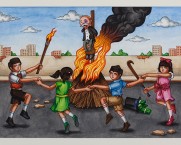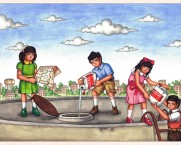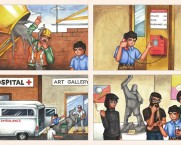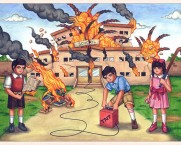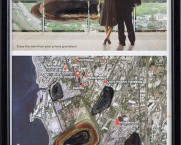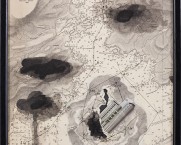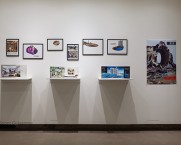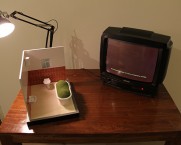C&L Shows
2015
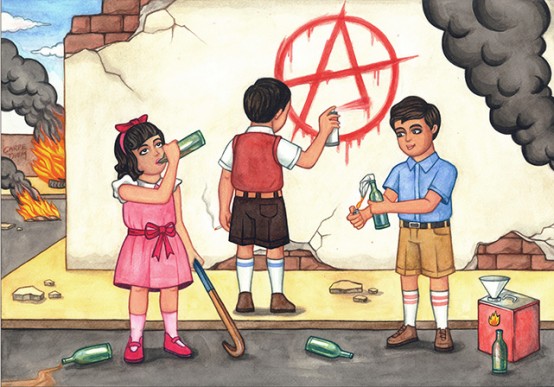
Overview
When, at the end of The Wizard of Oz, Dorothy tearily concludes, “There’s no place like home,”, it’s a cue for viewers to nod their heads and agree with the heroine’s world-weary wisdom about the security of the familiar. But what if, rather than the sentimental slogan we’ve come to accept them as, Dorothy’s words meant the opposite – that home doesn’t quite exist, that it’s all an elaborate ruse? It’s an unsettling thought that the four artists express eloquently. In works that are wry and ambitious, they quote from histories of the forms they engage with and infuse their sharp observations about endangered private spaces with ironic humour ranging from the subtle to the unconcealed.
Driving down a highway anywhere in the subcontinent, one would be hard-pressed not to scoff cynically at the gigantic billboards dotting the rur-urban landscape and promising perfect housing solutions for the affluent and upwardly mobile. With Happy Owners, Soazic Guézennec takes these ubiquitous manifestations of the lifestyle industry and exposes them for the farce they are. Mocking the unrestrained bombast of corporations’ advertisements, a contrast to the regulation of the speech of citizens, she cites the Kubakovs and Fabrice Hybert as influences. Harking back to her time owning and heading an ad agency, she created a fake real estate company complete with the communication materials typical of the ilk. Except that they actually convey the environmental disturbances wrought by the greed for luxurious living ‘close to nature’– vivid animation shows the metamorphosis of a glass façade into a giant aquarium, brochures peddle dreams of country idyll to the urban middle-class, black and white collages and vibrant paintings depict catastrophes befalling multi-storeyed apartment buildings. Guézennec turns on its head the glib notion of residing in harmony with natural surroundings through her low-key parody and old-fashioned illustrations gesturing to the ecological destruction already being caused by these projects.
In a similar vein, cocking a snook at the way real estate enterprises tempt customers is Oasis Grande-Tranquility, Chinmoyi Patel’s antic video based on advertisements featuring model homes in which she arranges herself as an earnest contemplator of the skyline. The pristine aesthetic of the interiors she films herself in seems like an apt comment on the cleanliness-fixated campaigns of the moment, red (or is it saffron?) herrings meant to distract those who would ask questions from, among other things, attending to the invisible collusions between controllers of land and operators of business.
Patel revisits the theme of directing attention in The Solid Melts into Sauce, her Baroda-set homage to John Smith’s art school classic The Girl Chewing Gum (1976), a piece that achieves great relevance by speaking to the current fascination with the CCTV-begotten phenomenon of ‘video sniffing’ as an artistic style. Her crisp, faux-authoritative voiceover belies the actual autonomy of the unwitting subjects of her video, moving on the road unaware that they’re being filmed though, of course, the spectator cottons on at once that the artist is only pretending to be in charge of the scene. This complicity between the artist and her viewer, this agreement to cohabit in a space of make-believe by mutual consent, is broadly reiterated by large cloth cactus sculptures that are handmade representations of organic forms, goofily pretending to be real. With a range of references from television to modern design history inspiring and informing her acts, Patel’s light-hearted and fluent pieces poke fun at the acquisitive and autocratic tendencies surfacing in a nation hung up on an exclusive notion of economic success.
The video works of Amshu Chukki are darker and more brooding, though not without a pitch- black sense of humour. An admirer of Alfred Hitchcock and Masao Adachi, Chukki discreetly pays tribute to the latter’s A.K.A. Serial Killer (1969) in Mountain Man, a recreation of a site-specific installation that he made in an old hotel in Pune, narrating a spooky story about dreams and death in terms of the geometry of a room “spied on” by the viewer through a peephole. Reflecting on whether houses have inner lives as rich and mysterious as humans and if buildings store secrets, Chukki splices auras belonging to spaces exhibitionary and intimate – the film set, the gallery and the house – to evoke the feeling of ‘having occupied’.
Challenging the notion of site-specificity by transplanting a place and collaborating with a model maker who rebuilt the ‘scene of the crime’, he mulls over what might have happened in a place, over the tales being told about it. The artist enters (and urges viewers to follow) once footsteps have receded and distant doors shut, to excavate sites of shared dreams that are often buried in the homes where the dreamers slept.
This fetishisation of the index and curiosity about collective dreaming is part of The Mountain, Les Invisibles as well. The Biodome in Montreal, the velodrome for the 1976 Olympics and now an enclosed ecological reserve, serves as the protagonist for this film. The utopian theories of the architect Buckminster Fuller are the foundation for the work, portraying the life of the Biodome through the memories, experiences and ideas of its employees set as voiceovers gliding over lingering sequences showing the space itself. The ‘expanded’ form of structure, visuality and spatiality that Fuller so presciently hinted at addressed a media-anxious moment in mid-century North America that might perhaps be recurring in a more frenetic avatar in South Asia. Chukki’s interest in the physical life of human-made artefacts and plots and their virtual afterlives as moving images delves into some of the possibilities of these expansions.
Somewhat dystopian in its thrust, Priyesh Trivedi’s Adarsh Balak series is an appeal to protect one’s individuality, imagination and hopes. He considers home to be a kind of psychological refuge from expectations and diktats, an escape from the demands of society and state. A cult Internet phenomenon and the most recognisable works on view, the deadpan derring-do of the eponymous ideal boy who indulges in less-than-ideal acts of truancy resonates with a generation that fondly remembers the Indian Book Depot charts of the ’80s and the ’90s. Meant for instructing young Indians in ‘decent’ behaviour, the charts took on a retroactively amusing hue when the people they were aimed at grew up and realised the silly-sinister undertones of conformity and compliance they had been fed. A subversion of the soft propaganda encoded in the original graphics in favour of post-globalisation hipster nostalgia, the comic piquancy of the works lies in its blatant and literal inversion of adarsh. Arson, vandalism, cruel pranks against presumably evil suits and lots of underage drinking characterise the works being exhibited, apart from the so-reviled-it’s-beloved oily-haired side-parting (in this part of the world, second only to the bowl cut in the hierarchy of traumatising hairstyles). The artist considers himself apolitical but the jabs and potshots taken at big business, conservative values and conventional orthodoxies indicate a disdain for the anachronistic, reactionary ways of life in India that continue to mar the most potent memories of being home – childhoods.
What do ordinary, unpretentious attempts at being homebound look like in an era beset by consumerist hallucinations of gloss and grandeur? What does it mean to be at home with oneself, resisting cultural and political pressures insistent on governing our inner domains as they do our material regimes? What do our homes get up to when we are away, when we aren’t looking? Through multimedia installations involving performance, video, sculptures and paintings on paper, the artists muse over and gently mock the meaning and status of home as a metaphor for the contemporary ecosystem of the everyday. They probe the aspirations of awkwardly industrialising societies as evinced from the architectures they desire, the habitats they construct (not cultivate) and the sort of childhoods they encourage, lampooning them with wit and heart.
Kamayani Sharma
Paper

